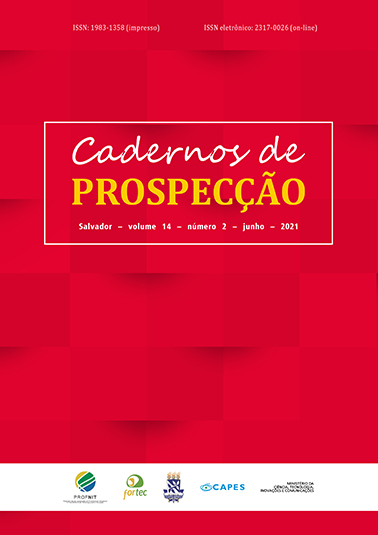Políticas Públicas e Desenvolvimento da Tecnologia Nacional: o caso brasileiro em comparação aos países asiáticos
DOI:
https://doi.org/10.9771/cp.v14i2.32502Palavras-chave:
Desenvolvimento Nacional, Políticas Públicas, Propriedade Intelectual.Resumo
O presente artigo visa a compreender a relação entre políticas públicas, Propriedade Intelectual e desenvolvimento e sua relevância para o Brasil. Para tanto, foram analisados três casos de sucesso em desenvolvimento tecnológico: da China, da Coreia do Sul e de Taiwan, com fins de comparação ao caso brasileiro. Para a devida análise, utilizou-se material bibliográfico pertinente ao tema. Dessa forma, foram apresentados o histórico de cada país, as estratégias empregadas para o êxito de seus objetivos e os índices alcançados. Depois, fez-se um breve levantamento do caso brasileiro, sinalizando os pontos positivos e negativos presentes e os desafios pertinentes. Por fim, foi possível notar uma íntima relação entre Propriedade Intelectual, políticas públicas e desenvolvimento nacional, fatores que influenciam diretamente no crescimento nacional.Downloads
Referências
ARBIX, G. Políticas de inovação em nova chave. Estudos Avançados, São Paulo, v. 31, p. 49-73, 2017.
BARBOSA, D. B. Ensaios e estudos de Propriedade Intelectual 2014-2015: Volume III. Edição do Instituto Brasileiro da Propriedade Intelectual, 2015. 806 p.
BARRERA, Alex. Forget Silicon Valley: Innovation is happening in China now. [2017]. Disponível em: https://becominghuman.ai/forget-silicon-valley-innovation-is-happening-in-china-now-c6cfdbd74bc4. Acesso em: 15 jun. 2019.
BERGQUIST, K.; FINK, C.; RAFFO, J. Identifying and ranking the world’s largest science and technology clusters. [2018]. Disponível em: https://www.wipo.int/edocs/pubdocs/en/wipo_pub_gii_2018-chapter14.pdf. Acesso em: 14 jun. 2019.
BRASIL DEBATE. A aposta chinesa na inovação. [2015]. Disponível em: http://brasildebate.com.br/a-aposta-chinesa-na-inovacao/ Acesso em: 14 jun. 2019.
CHINA POWER. Is China a global leader in research and development? [2016]. Disponível em: https://chinapower.csis.org/china-research-and-development-rnd/ Acesso em: 14 jun. 2019.
CORREA, C. Intellectual Property Rights, the WTO and Developing Countries. 2. ed. Londres: Zed Books, 2000.
EMBASSY OF THE PEOPLES’S REPUBLIC OF CHINA IN THE UNITED KINGDOM OF GREAT BRITAIN AND NORTHERN IRELAND. International Science and Technology Exchange and Coorperation. [2019]. Disponível em: http://www.chinese-embassy.org.uk/eng/zygx/st/t27120.htm. Acesso em: 14 jun. 2019.
ERIKSSON, S. Innovation Policies in South Korea and Taiwan. Suécia: Vinnova, 2005. 72p.
FISHER, T. When Is 5G Coming to South Korea? (Updated for 2019). Disponível em: https://www.lifewire.com/5g-south-korea-4583813. Acesso em: 14 jun. 2019.
GUISE, M. Propriedade intelectual no mundo contemporâneo: fomento ao desenvolvimento? In: XV CONGRESSO NACIONAL DO CONPEDI – CONSELHO NACIONAL DE PESQUISA E PÓS-GRADUAÇÃO EM DIREITO, 2006. Anais [...]. 2006.
INPI – INSTITUTO NACIONAL DA PROPRIEDADE INDUSTRIAL. Metas e resultados: balanço da gestão 2015-2018. [2019]. Disponível em: http://www.inpi.gov.br/arquivos/INPI_metas_e_resultados_balanco_gestao_20152018.pdf. Acesso em: 14 jun. 2019.
LYRIO, M. C. A ascensão da China como potência: fundamentos políticos internos. 2. Edição. Brasília: Fundação Alexandre de Gusmão, 2010. 250p.
MITRA, R. 5G mobile technology: a survey. ICT Express Volume 1, Issue 3, December 2015, Pages 132-137, Seocho-gu: 2015. (Korea Institute of Communication Sciences)
NATIONAL BUREAU OF STATISTICS OF CHINA. China statistical yearbook 2017. Disponível em: http://www.stats.gov.cn/tjsj/ndsj/2017/indexeh.htm. Acesso em: 14 jun. 2019.
OCDE – ORGANIZAÇÃO PARA A COOPERAÇÃO E DESENVOLVIMENTO ECONÔMICO. Chinese innovation. [2019a]. Disponível em: http://oecdobserver.org/news/archivestory.php/aid/2496/Chinese_innovation_.html. Acesso em: 15 jul. 2019
OCDE – ORGANIZAÇÃO PARA A COOPERAÇÃO E DESENVOLVIMENTO ECONÔMICO. Main science and technology indicators. [2019b]. Disponível em: https://stats.oecd.org/Index.aspx?DataSetCode=MSTI_PUB. Acesso em: 14 jun. 2019.
O’MEARA, S. Ten institutions that dominated science in 2015. [2016]. Disponível em: https://www.natureindex.com/news-blog/ten-institutions-that-dominated-science-in-twentyfifteen. Acesso em: 14 jun. 2019.
ORSZAG, P. R. China Is Overtaking the U.S. in Scientific Research. [2018]. Disponível em: https://www.bloomberg.com/opinion/articles/2018-09-12/chinese-researchers-are-outperforming-americans-in-science. Acesso em: 14 jun. 2019.
OYENIRA, R.; UWAMAHORO, E. Impacts of Reforms in Chinese Educational System. [2019]. Disponível em: http://www.macrothink.org/journal/index.php/ije/article/viewFile/10495/8733. Acesso em: 14 jun. 2019.
SOARES, R. Regime jurídico de proteção à propriedade industrial no Brasil. Revista Direito e Liberdade, Natal, v. 13, n. 1, p. 157-172, 2011. (Revista Direito e Liberdade da Escola da Magistratura do RN)
STARTSE. Mergulhando no ecossistema empreendedor da China. [2018]. Disponível em: https://lp.startse.com.br/material-rico/e-book-mergulhando-no-ecossistema-empreendedor-da-china/. Acesso em: 2 jul. 2019.
THOMSON REUTERS. Top 100 global tech leaders 2018. [2018]. Disponível em: https://www.thomsonreuters.com/en/products-services/technology/top-100.html. Acesso em: 6 jul. 2019.
WORLD ECONOMIC FORUM. China is an innovation superpower this is why. [2018]. Disponível em: https://www.weforum.org/agenda/2018/02/these-charts-show-how-china-is-becoming-an-innovation-superpower/. Acesso em: 14 jun. 2019.
YUCING, G. G. China o impacto das reformas econômicas chinesas dentro e fora do país. [2013]. Disponível em: https://pucminasconjuntura.wordpress.com/2013/09/07/china-o-impacto-das-reformas-economicas-chinesas-dentro-e-fora-do-pais/. Acesso em: 2 jul. 2019.
Downloads
Publicado
Como Citar
Edição
Seção
Licença
Copyright (c) 2021 Cadernos de Prospecção

Este trabalho está licenciado sob uma licença Creative Commons Attribution-NonCommercial 4.0 International License.
O autor declara que: - Todos os autores foram nomeados. - Está submetendo o manuscrito com o consentimento dos outros autores. - Caso o trabalho submetido tiver sido contratado por algum empregador, tem o consentimento do referido empregador. - Os autores estão cientes de que é condição de publicação que os manuscritos submetidos a esta revista não tenham sido publicados anteriormente e não sejam submetidos ou publicados simultaneamente em outro periódico sem prévia autorização do Conselho Editorial. - Os autores concordam que o seu artigo ou parte dele possa ser distribuído e/ou reproduzido por qualquer forma, incluindo traduções, desde que sejam citados de modo completo esta revista e os autores do manuscrito. - Revista Cadernos de Prospecção está licenciado com uma Licença Creative Commons Attribution 4.0. Esta licença permite que outros remixem, adaptem e criem a partir do seu trabalho para fins não comerciais, e embora os novos trabalhos tenham de lhe atribuir o devido crédito e não possam ser usados para fins comerciais, os usuários não têm de licenciar esses trabalhos derivados sob os mesmos termos.
Este obra está licenciado com uma Licença Creative Commons Atribuição 4.0 Internacional.








